WITH

CARL BARKS
( This Article originally appeared in
Crusader Comments, Buyers Guide, Circa 1973)
A CASUAL VISIT
WITH

CARL BARKS
( This Article originally appeared in
Crusader Comments, Buyers Guide,
Circa 1973)
by Dan Gheno
Carl Barks’ maxim seems to be perfection and imagination. As the clichéd commercial goes, he "accepts no substitutes." Even his house, located in a small Santa Barbara suburb, is not an exception to this rule. Squatting proudly over the surrounding tract houses, Barks’ house is as imaginative and "epic" as his duck stories. It’s situated near a corner and is facing the street at an angle. Like two playing cards, leaning together, his house is of a futuristic design and triangular in form. But then, what the master lives in is beside the point. What went on inside, one day, is the subject of this piece.
It was late in March, on a windy
Saturday evening. The four of us, Mark
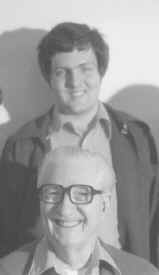 Evanier (Beagle Boys scripter extraordinaire, standing behind Barks in 1973
photo on left), John Pound (Ronald Rabbit artist extraordinaire), Bob Kline (dinosaur man
extraordinaire) and I (nothing extraordinaire) were dumbfounded with keen apprehension
as we gingerly approached
his door. Being the bravest of our troop, I took the initiative and pressed his
door bell. We stood hushed for a moment as we formed, in our minds, myriad
visions of this great man. Oh, we had seen photos of him before, but we were not
convinced that they were authentic. Fakes! They had to be fakes! Then, the door
slowly parted. We expected a gruff incarnation of Uncle Scrooge to Jump out, but
what pushed open the door could hardly be likened to Duckvllle’s old miser.
Rather, Carl Barks was the ideal image of everyone’s grandfather. He had a
kind smile and his voice was quiet and soothing like Capt. Kangaroo’s and Mr.
Rogers.
Evanier (Beagle Boys scripter extraordinaire, standing behind Barks in 1973
photo on left), John Pound (Ronald Rabbit artist extraordinaire), Bob Kline (dinosaur man
extraordinaire) and I (nothing extraordinaire) were dumbfounded with keen apprehension
as we gingerly approached
his door. Being the bravest of our troop, I took the initiative and pressed his
door bell. We stood hushed for a moment as we formed, in our minds, myriad
visions of this great man. Oh, we had seen photos of him before, but we were not
convinced that they were authentic. Fakes! They had to be fakes! Then, the door
slowly parted. We expected a gruff incarnation of Uncle Scrooge to Jump out, but
what pushed open the door could hardly be likened to Duckvllle’s old miser.
Rather, Carl Barks was the ideal image of everyone’s grandfather. He had a
kind smile and his voice was quiet and soothing like Capt. Kangaroo’s and Mr.
Rogers.
After introductions were concluded, he led us into his house and ushered us
to his living room. There, he proudly brought our attention to some of his wife’s
fine paintings. He then had us sit down and he showed us two colorful books from
Italy. Their contents? Two beautiful collections of 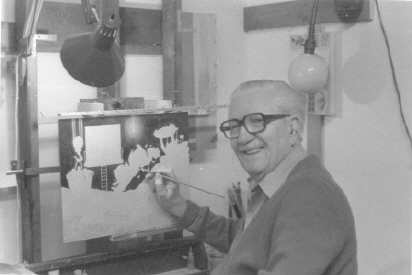 Barks’ better Donald Duck
and Mickey Mouse stories. Well praised for the high quality grain of paper and
superb printing process used in its production, the books, Barks explained were
in great demand. Leafing through the bright books, Mark Evanier observed,
"America’s books are considered the best throughout Europe, and yet, it
takes an European country to do our work justice. Everyone agreed. Then, Barks
pulled out an envelope and showed it to Bob Kline. The letter enclosed was from
a comic art museum in an Italian costal city and it was asking Barks for an
original page of art to add to its collection. Barks wasn’t sure, at the time,
whether he was going to give them any of his old work. He did say though how
much he would like to see a museum, like Italy’s, spring up in America.
Barks’ better Donald Duck
and Mickey Mouse stories. Well praised for the high quality grain of paper and
superb printing process used in its production, the books, Barks explained were
in great demand. Leafing through the bright books, Mark Evanier observed,
"America’s books are considered the best throughout Europe, and yet, it
takes an European country to do our work justice. Everyone agreed. Then, Barks
pulled out an envelope and showed it to Bob Kline. The letter enclosed was from
a comic art museum in an Italian costal city and it was asking Barks for an
original page of art to add to its collection. Barks wasn’t sure, at the time,
whether he was going to give them any of his old work. He did say though how
much he would like to see a museum, like Italy’s, spring up in America.
While the others continued to talk, I wandered to a wall which held some of Barks’ acrylic paintings. He soon came up behind me and explained that the painting I was oogling didn’t come out as he wanted it. It looked great to me, but he said that his dabbling in acrylics was only an experiment and that he quickly returned to oils, dissatisfied with his Progress. Modesty of this type is common among genius artists!
At this time, Barks’ wife entered and introduced herself. She
suggested 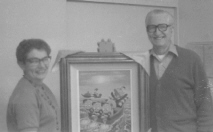 that We move to a room with better light, and she led us to Barks’ studio. The
Studio smelled pleasantly of oils. Standing to one corner, in front of a
closet, was an easel, which cradled a painting in preparation. Opposite
the easel, on the other side of the room, were two paintings in different stages
of completion.
that We move to a room with better light, and she led us to Barks’ studio. The
Studio smelled pleasantly of oils. Standing to one corner, in front of a
closet, was an easel, which cradled a painting in preparation. Opposite
the easel, on the other side of the room, were two paintings in different stages
of completion.
As we stood there gawking at his paintings, Mrs. Barks remarked, "Chase (Chase Craig, Gold Key’s Hollywood editor) finally let Carl quit writing The Junior Woodchucks. The one he sent in, the other day, was the very last story."
"I had an awful lot of trouble with that one," Carl said. "I was battling all the way. I just don’t have the imagination that I used to have in the old days." Looking at Evanier, Kline and Pound, he continued, "I’m glad I don’t have to compete with you guys any longer."
Everyone assured him otherwise—that he still had it in him——but Barks said that he was supposed to have retired a long time ago. However, with his combined painting and Woodchuck scripting, he wasn’t able to enjoy it as much as he wished. Now, he hoped that he could devote more time to his duck paintings.
He brought out a long list and showed us how many people he was committed to for paintings. "I finally had to put a stop to it, because the list was getting too long. As it is, I’ll be painting well into 1976!"
Looking over a painting, I commented on the odd surface he was working
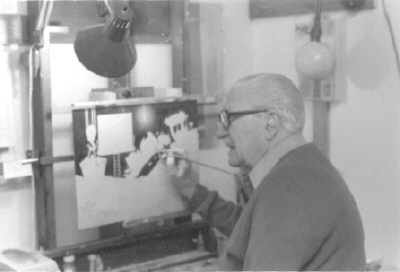 with.
It looked like very thick, rocklike tracing paper. Barks gave a chuckle and told
me that it was a smooth tiling that must be purchased by the ton. Each of us
whewed! "We buy it in lower quantities from a friend, though, who buys it by
the ton."
with.
It looked like very thick, rocklike tracing paper. Barks gave a chuckle and told
me that it was a smooth tiling that must be purchased by the ton. Each of us
whewed! "We buy it in lower quantities from a friend, though, who buys it by
the ton."
With that, we returned to his living room and they offered us a coke. We accepted and as they poured the drinks, Barks handed us some photos of his paintings to look through. Among the many photos we waded through, we ran across some pictures of Barks’ close friend, Russell Myers (Broom Hilda’s artist). They showed Myers holding up a couple of his paintings. Somewhat like Lichtenstein's work, his paintings , rendered on enormous sized canvasses, were blow-ups of old comic pages and panels. Later, we stumbled on a photo of Roy Thomas holding a painting Barks had done for him.
As we guzzled down the last of our Cokes, Barks pulled out a photo-statted copy of his very last "Woodchuck" script. Yet, unlike most comic book scripts it was not type written. On the contrary, it was drawn out, panel by panel. It was rendered so expertly, that the script alone could easily serve as the finished product.
Avoiding wordy dissertations, Barks composes his stories with just enough visual action. He
balances on a thin line between visual illustration and prose, and he comes to market with a
product that is extremely smooth flowing. His last story for Western is no
exception. Each panel my eyes alighted on, was classically Barks. 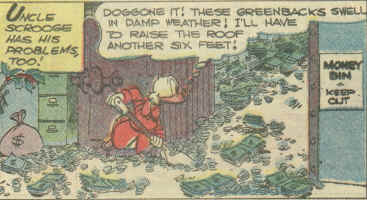 All of the funny
expressions, all of the sight gags, all of the subtle slapstick was present as usual. And, though it was not
needed for a draft script, all of the
detail Barks, is known for was there as well.
All of the funny
expressions, all of the sight gags, all of the subtle slapstick was present as usual. And, though it was not
needed for a draft script, all of the
detail Barks, is known for was there as well.
About detail in his old stories, Barks said: "I tried to do something extra with my art, other than what everyone else was doing at the time. So, I put in a little extra detail. I could never warm up to doing something like Superman. It’s just too much work."
And about composition in general, Barks had this to say, "While I worked at the studio (Disney), they would constantly tell us that the main objective was to keep the audience’s eye focused on the center of interest. I carried this over to my duck work as I tried to keep one’s eye from wandering from the main character. Everything else was incidental and in the background."
At this point, John Pound and Bob Kline brought out some of their own artwork
that they happened to bring along. On seeing one of Kline's dinosaur and assorted monster paintings, Mrs. Barks gasped how
realistic they looked.
She went on to say that there was much talent in fandom which was going relatively un-rewarded.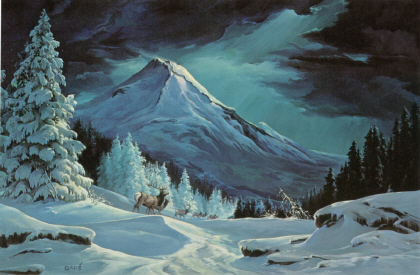 She said, "The nature field, which has all the rich
people that could pay for and appreciate animal studies painted realistically, like Bob’s fantasy work, has very few good artists. Many of the good
fan painters could fill this void." She continued, saying that she would
like to see more people get into the nature field where they could find a more ready
and generous market (The above painting is by Gare Barks).
She said, "The nature field, which has all the rich
people that could pay for and appreciate animal studies painted realistically, like Bob’s fantasy work, has very few good artists. Many of the good
fan painters could fill this void." She continued, saying that she would
like to see more people get into the nature field where they could find a more ready
and generous market (The above painting is by Gare Barks).
Soon, Barks and his wife were finished browsing through Kline and Pound’s work, and Evanier noticed, by his watch, that our intended hour long visit had lapsed into a two hour marathon. Mickey Mouse’s big hand was quickly approaching the heavy number ten. Thanking the Barks’ for a memorable evening, we started for the door. Fifteen minutes later we still stood outside his door shaking hands and repeating our thanks.
There were none of the usual wisecracks as we chugged away from Barks’ brightly lit house. We had met the mastermind behind our childhood fantasies and we were dumbly euphoric!
______________________________
Carl Barks passed
away recently, August 2000 at age 99. He had a kind spirit, a generous heart,
and he possessed an unsurpassed visual and story-telling genius. He will be missed by the
many who knew him personally and those who knew only his timeless work.
___________________________________
The above article and all photographs are © 2000 by Dan Gheno. All rights reserved. You may not republish the article or photos without written permission of the author. Uncle Scrooge image © 2000 Walt Disney
| Dan Gheno Painting and Drawing Home Page |